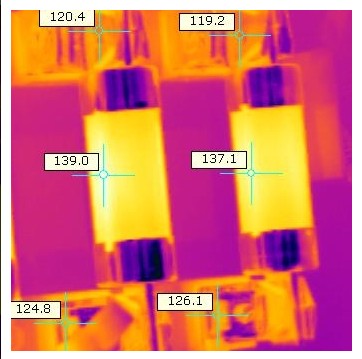Where do you place your temperature spot tool on your thermal scans?
I have had this conversation several times recently with infrared thermographers and have noticed a large number of thermal scans on the Internet so I thought I would discuss a little bit with you thermal guys.
This thermal scan belongs to "we know who", and I am only using this because it shows a very good example of the subject, not that there is anything wrong with it. I use it without his permission!?
Geometry in thermal imaging plays a very important role in what our cameras see and record as apparent temperature. It can improve the accuracy of the apparent temperature when concave and it can distort the readings when convex.
RAT (reflected apparent temperature) is used in a process to correct apparent temperatures in our scans. It is one of those processes that we frequently overlook or feel is unnecessary because we are not looking for specific temperature adjustment. However, the RAT has a significant role in how things appear in our thermal scans.

In this scan we see a higher temperature to the left of center of the fuse cartridges.
Is this actually the most accurate temperature of the fuses?
When we do electrical scans, we are looking for heat sources. Generally there are a lot of them around in the panel and in the utility room. Very often the heat source within the panel radiates (as well as raise the temperature of other components in the panel through convection).
If we think "reflection", we can imagine this effect on other objects. The cartridge fuse may be reflecting a heat source on the left side of the fuses causing an increased apparent temperature left of center.
This frequently occurs on wiring, and other cylindrical shaped objects.
In our example however, we can see the effects of the RAT on the metallic ends of the fuses. We know that Low emissivity (reflective), convex objects record ambient temperature conditions in the room rather than their actual temperature.
The center of the metallic fuse caps show very cool temperatures in comparison to anything else inside the electrical service panel. We should never forget that cold reflects, just as we normally perceive high temperature reflection.
If we placed the temperature spot meter on the center of the fuse cartridge, we would find a lower temperature reading.
So which one is correct?
What we see in the metallic end caps is what is affecting the temperature recorded on the center of the fuses. The total apparent temperature is the sum of that which is being emitted from the fuse cartridge plus the reflected apparent temperature. If the reflected apparent temperature is lower than the ambient temperature of the electrical panel, a negative integer effects the equation.
So in this case, the cold conditions in the room (behind the camera) is lowering the temperature measurement of the cartridge fuse. The diffused reflection on the fuse body is much less apparent than the specular reflection on the metallic end caps, but it is still there.
If the thermographer where to tune the scan for the body of the fuse only, we would see the dark blue areas of the end caps would extend through the highly emissive fuse body and connect with one another. If you look closely, you can see it even here.
So not only is the RAT important for correcting the apparent temperatures, it is critical as to where we locate our spot temperature tool on the scan (even when we are only conducting quantitative assessment).
In this case the thermographer correctly located the spot temperature tool left of center because the effects of the cold conditions behind the camera causes a greater error factor than at any other location on the fuse.
Selecting this location is not always based on this evaluation however. Thermographers frequently place the spot temperature tool at the highest temperature recorded on the object. Very often, this is not the correct location. We have a tendency to want to exaggerate the effects we observe in the scan by selecting the highest recorded temperature on the object without consideration for its accuracy.


